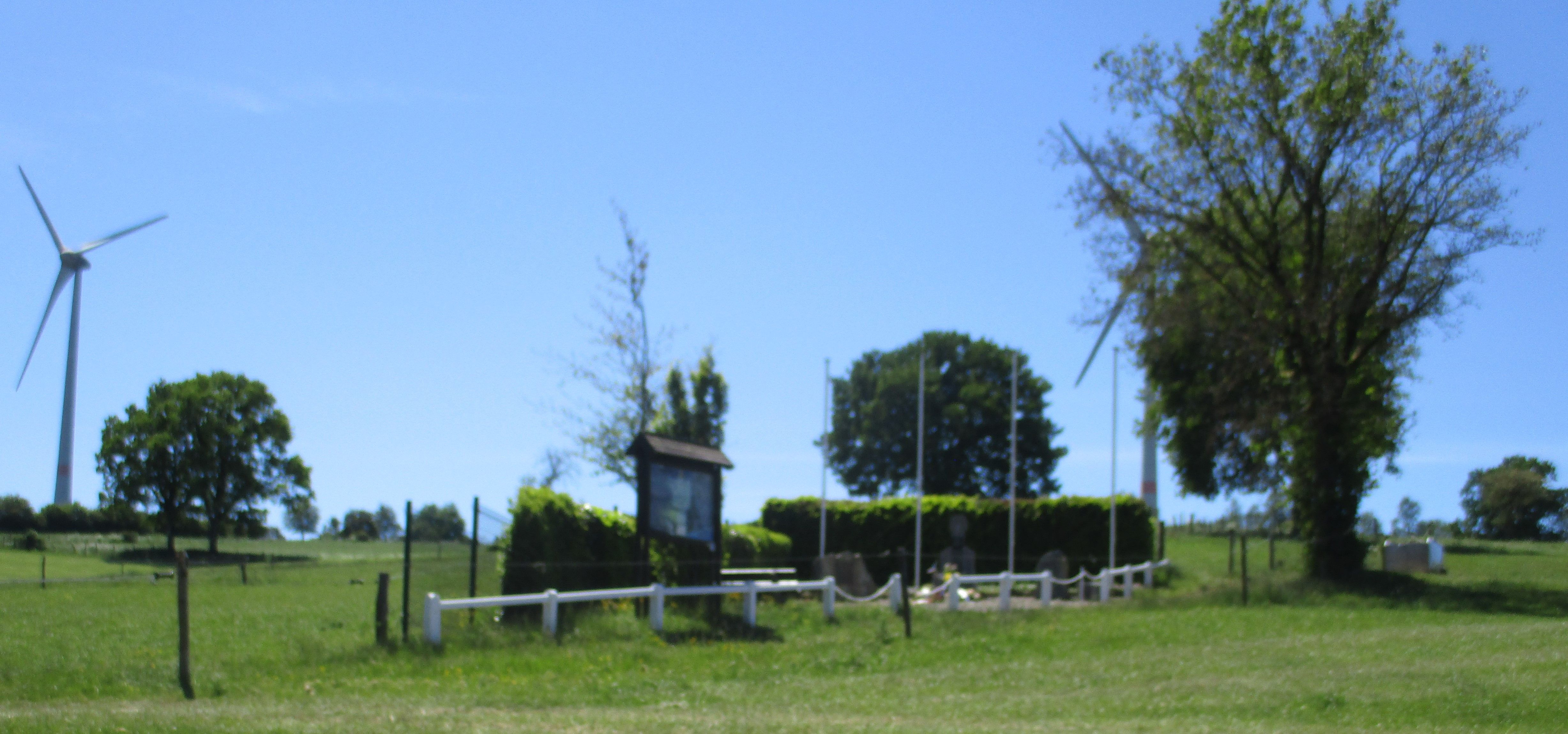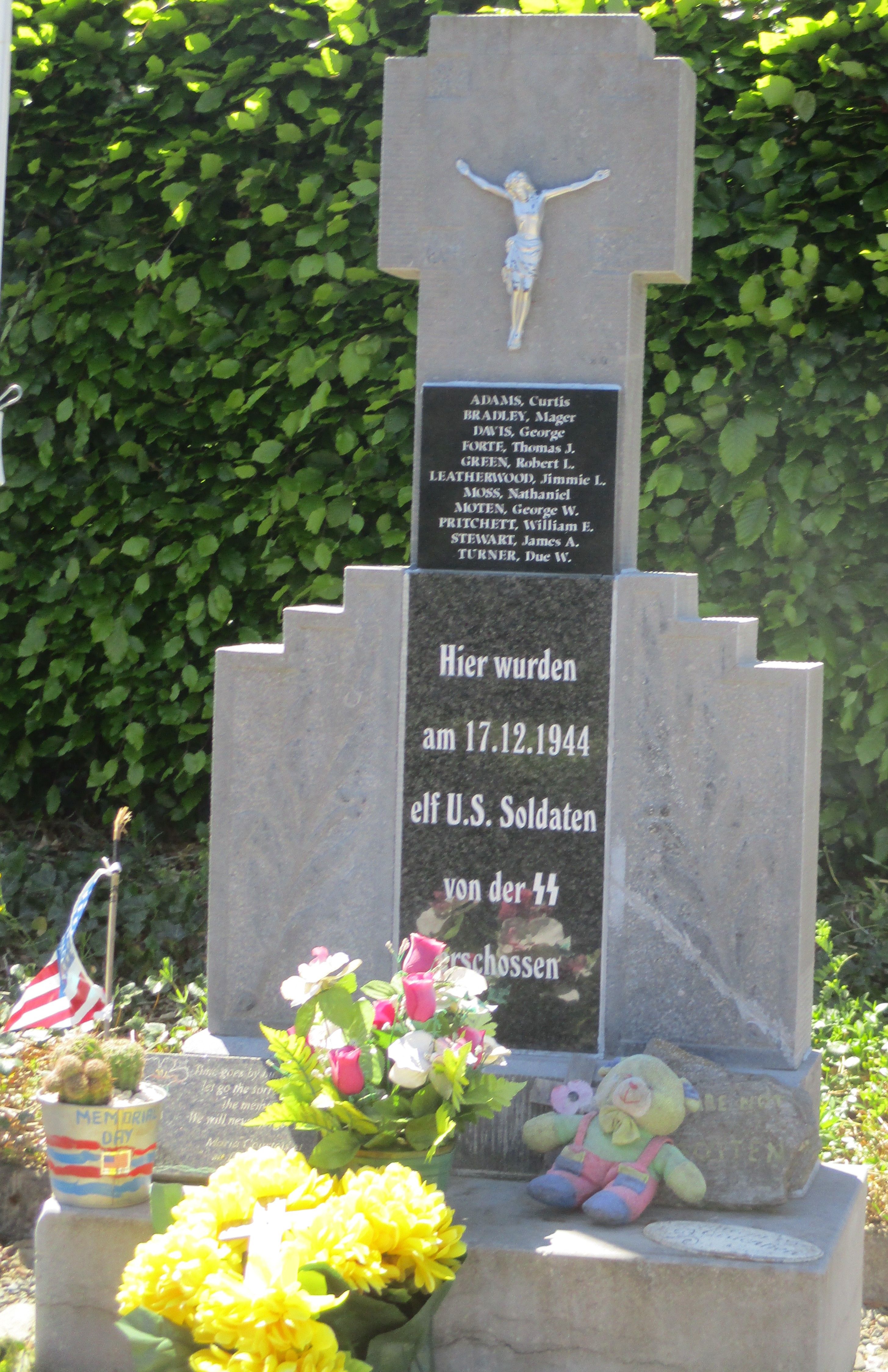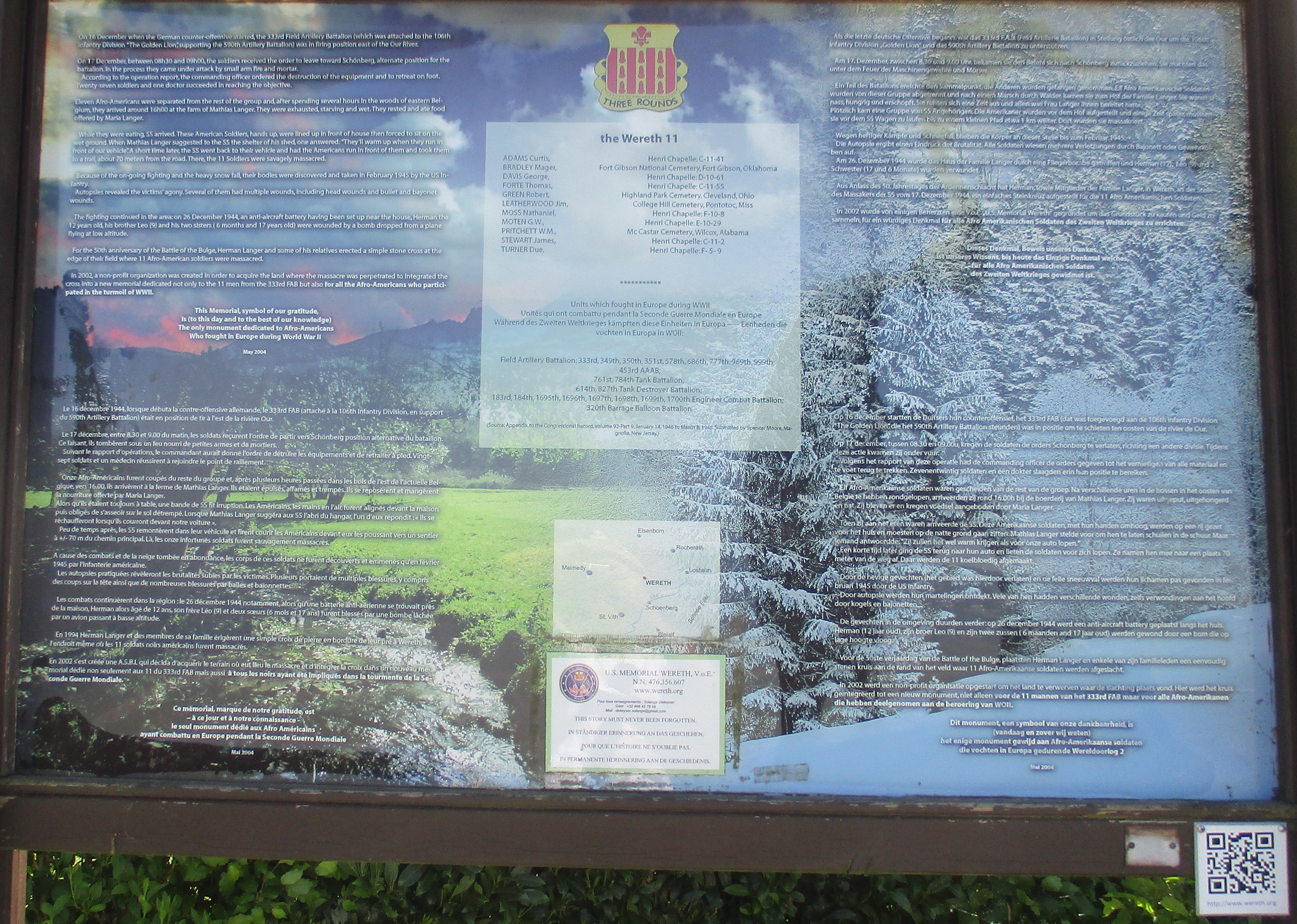Their combat story begin on 17 December 1944. Battery C of 333rd Field Artillery Battalion was flanked and overrun. Most of the troops were killed or captured. Eleven soldiers became separated from the unit after it was overrun early on the second day of the battle. They tried to find the American lines but were unable to and when they reached the hamlet of Wereth, Belgium, farmer Mathias Langer, offered them shelter. The portion of Belgium they were in had been German territory prior to World War I and three of the nine homes in the village were loyal to Germany. The wife of a German soldier who lived in the town told members of the 1st SS Division about the black American GIs hiding in the town. The Germans captured the troops and took them to a nearby field, where they tortured, maimed, and shot all 11 soldiers.
The remains of the 11 troops were found by Allied soldiers six weeks later, in mid-February, after the Allies re-captured the area. The Germans had battered the soldiers' faces, cut their fingers off, broken their legs, used bayonetts to stab them in the eye,[citation needed] and shot at least one soldier while he was bandaging a comrade's wounds.
The remnants of the 333rd FAB were ordered to Bastogne and incorporated into its sister unit the 969th Field Artillery Battalion. Both units provided fire support for the 101st Airborne Division in the Siege of Bastogne, subsequently being awarded the Presidential Unit Citation.
The 333rd Field Artillery Battalion suffered more casualties during the Battle of the Bulge than any other artillery unit in the VIII Corps. Six officers (including the commanding officer) and 222 enlisted men were casualties or became prisoners of war. The 333rd FA Group subsequently served in the Central Europe campaign until the end of the war, while the 333rd FA Battalion subsequently served in the Rhineland Campaign.
A 1949 Senate Armed Services Committee documented and investigated 12 incidents of Nazi troops massacring captured American troops and Belgian civilians during the Battle of the Bulge, but the Committee's report omitted the killings in Wereth, and history nearly overlooked the horrific deaths of the 11 members of the 333rd Field Artillery Battalion.
In 2004, a permanent monument was dedicated in Wereth to the 11 African- American soldiers of the 333rd Field Artillery Battalion who lost their lives in Wereth during the Battle of the Bulge in an effort to defeat fascism and defend freedom.
In December 2013, U.S. Reps. Jim Gerlach (PA-6th District) and Chaka Fattah (PA-2nd District) introduced a resolution that would formally recognize the valor and sacrifice of 11 black soldiers captured, tortured and ruthlessly executed by Nazi troops in a pasture in Wereth, Belgium on the second day of the Battle of the Bulge.
The resolution, H. Con. Res. 68, also calls on the U.S. Senate's Armed Services Committee to revise a 1949 subcommittee report to include an appropriate recognition of the massacre of the 11 black soldiers of the 333rd Field Artillery Battalion of the U.S. Army who were beaten, stabbed and shot multiple times at the hands of their Nazi captors on December 17, 1944. On September 19, 2016, Senate Res. 571 officially recognized the dedicated service and ultimate sacrifice on behalf of the United States of the 11 African-American soldiers of the 333rd Field Artillery Battalion of the United States Army who were massacred in Wereth, Belgium, during the Battle of the Bulge on December 17, 1944.
Their combat story begin on 17 December 1944. Battery C of 333rd Field Artillery Battalion was flanked and overrun. Most of the troops were killed or captured. Eleven soldiers became separated from the unit after it was overrun early on the second day of the battle. They tried to find the American lines but were unable to and when they reached the hamlet of Wereth, Belgium, farmer Mathias Langer, offered them shelter. The portion of Belgium they were in had been German territory prior to World War I and three of the nine homes in the village were loyal to Germany. The wife of a German soldier who lived in the town told members of the 1st SS Division about the black American GIs hiding in the town. The Germans captured the troops and took them to a nearby field, where they tortured, maimed, and shot all 11 soldiers.
The remains of the 11 troops were found by Allied soldiers six weeks later, in mid-February, after the Allies re-captured the area. The Germans had battered the soldiers' faces, cut their fingers off, broken their legs, used bayonetts to stab them in the eye,[citation needed] and shot at least one soldier while he was bandaging a comrade's wounds.
The remnants of the 333rd FAB were ordered to Bastogne and incorporated into its sister unit the 969th Field Artillery Battalion. Both units provided fire support for the 101st Airborne Division in the Siege of Bastogne, subsequently being awarded the Presidential Unit Citation.
The 333rd Field Artillery Battalion suffered more casualties during the Battle of the Bulge than any other artillery unit in the VIII Corps. Six officers (including the commanding officer) and 222 enlisted men were casualties or became prisoners of war. The 333rd FA Group subsequently served in the Central Europe campaign until the end of the war, while the 333rd FA Battalion subsequently served in the Rhineland Campaign.
A 1949 Senate Armed Services Committee documented and investigated 12 incidents of Nazi troops massacring captured American troops and Belgian civilians during the Battle of the Bulge, but the Committee's report omitted the killings in Wereth, and history nearly overlooked the horrific deaths of the 11 members of the 333rd Field Artillery Battalion.
In 2004, a permanent monument was dedicated in Wereth to the 11 African- American soldiers of the 333rd Field Artillery Battalion who lost their lives in Wereth during the Battle of the Bulge in an effort to defeat fascism and defend freedom.
In December 2013, U.S. Reps. Jim Gerlach (PA-6th District) and Chaka Fattah (PA-2nd District) introduced a resolution that would formally recognize the valor and sacrifice of 11 black soldiers captured, tortured and ruthlessly executed by Nazi troops in a pasture in Wereth, Belgium on the second day of the Battle of the Bulge.
The resolution, H. Con. Res. 68, also calls on the U.S. Senate's Armed Services Committee to revise a 1949 subcommittee report to include an appropriate recognition of the massacre of the 11 black soldiers of the 333rd Field Artillery Battalion of the U.S. Army who were beaten, stabbed and shot multiple times at the hands of their Nazi captors on December 17, 1944. On September 19, 2016, Senate Res. 571 officially recognized the dedicated service and ultimate sacrifice on behalf of the United States of the 11 African-American soldiers of the 333rd Field Artillery Battalion of the United States Army who were massacred in Wereth, Belgium, during the Battle of the Bulge on December 17, 1944.
Bio by: skegee
Advertisement
See more Wereth 11 Memorial memorials in:
Advertisement





